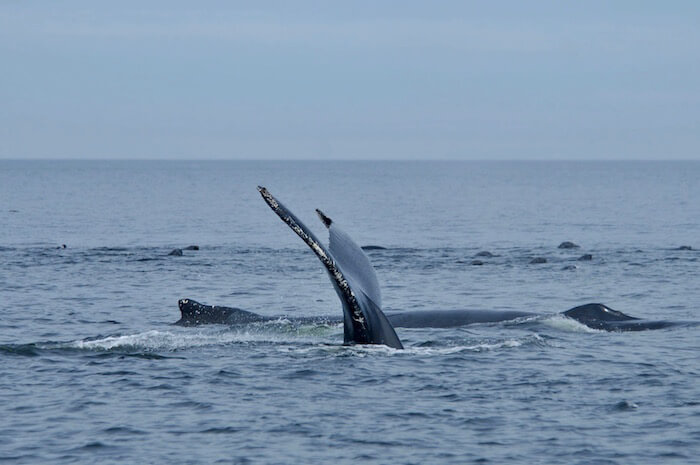As the first snow falls on the St. Lawrence, some whales continue to behave as if summer has never ended. Observers are becoming rarer, but for those around the Estuary who persevere, the wait is worth it.
Two humpback whales were still being reported last week between Les Bergeronnes and Les Escoumins, sometimes off Quai des Pilotes, sometimes off Cap de Bon-Désir. A little more than ten days ago, an observer stationed at the Tadoussac dunes was able to spot a blue whale slowly cruising through the middle of the Estuary. Harp seals, arriving from the North, are also present, mixed in with a few harbour porpoises and highly active minke whales. What was that in that patch of turbulent waters off the Cape on the morning of November 28? Dolphins? Seals on the move? Impossible to know for sure, but there was life there!
There has also been diversity farther downstream, in the Franquelin area; in mid-November, up to four humpbacks were seen by our dedicated observer. Then, to her surprise, a hundred or so dolphins passed by, “a first since I have been participating as a News from Afield observer!” she exclaims, visibly exited. Otherwise, the more common species such as minke whales, harbour porpoises and seals are also part of the marine mammal mix being observed early this winter.
The GREMM team working out of the offices of the Marine Mammal Interpretation Centre has been reporting belugas swimming in the mouth of the Saguenay almost daily. Then on Monday, November 28, an observer watched a group of about fifty of these small white whales stream past the rocks in Les Bergeronnes.
Little is known about where belugas concentrate in winter, but we do know that they do not leave the waters of the St. Lawrence. Aerial surveys have already helped researchers conclude that belugas are absent from the portion of the Estuary upstream of the Saguenay River during the winter months and seem instead to concentrate between the mouth of the Saguenay and Pointe-des-Monts. This distribution coincides with the findings of Vadim Vladykov –a researcher who was active in the 1940s – based on observations by local residents. During winter surveys, belugas were observed along the Gaspé coast as far as Cloridorme and in the northern part of the Gulf as far as the Sept-Îles region and Jacques Cartier Strait (between Anticosti Island and the North Shore). This downstream movement in autumn and winter could be related to the migration toward the Atlantic of some prey favoured by beluga such as herring and eel, or a search for areas where choppy seas prevent ice from forming.





